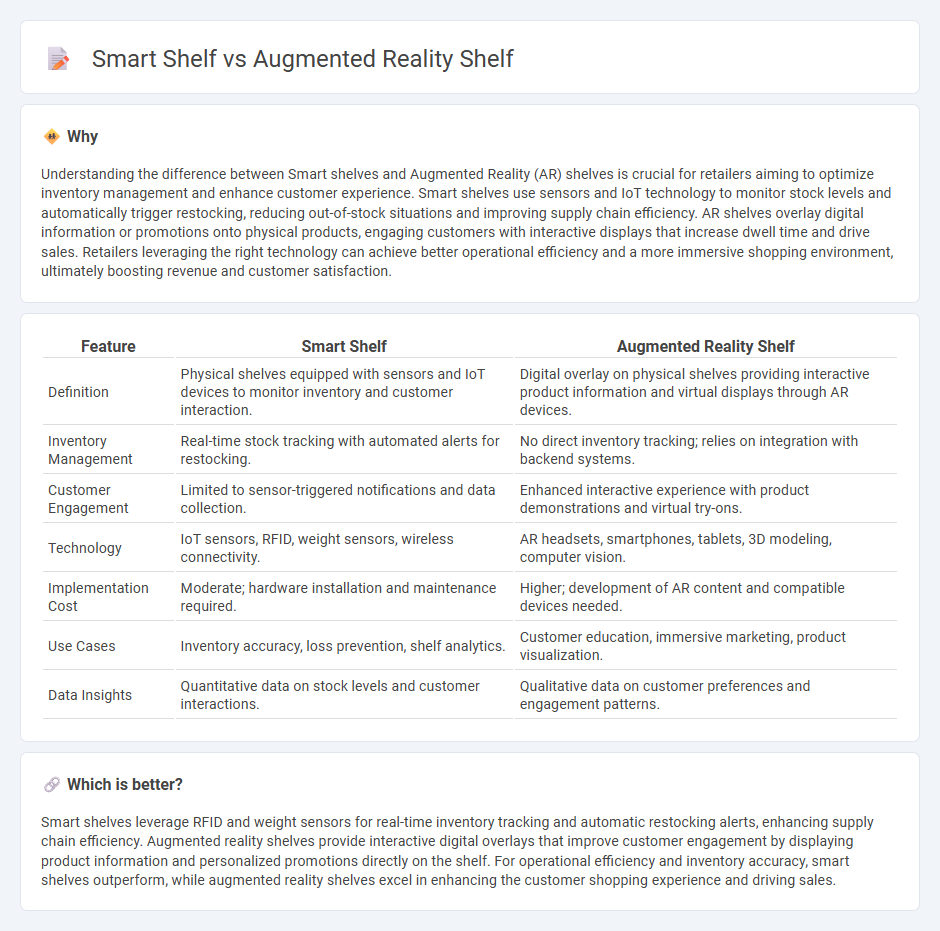
Smart shelves utilize sensors and RFID technology to automatically track inventory levels and shopper behavior in real-time, enhancing store efficiency and product availability. Augmented reality (AR) shelves offer immersive digital overlays that provide interactive product information and personalized shopping experiences through smartphones or AR glasses. Discover how combining smart shelf technology with augmented reality can revolutionize retail environments.
Why it is important
Understanding the difference between Smart shelves and Augmented Reality (AR) shelves is crucial for retailers aiming to optimize inventory management and enhance customer experience. Smart shelves use sensors and IoT technology to monitor stock levels and automatically trigger restocking, reducing out-of-stock situations and improving supply chain efficiency. AR shelves overlay digital information or promotions onto physical products, engaging customers with interactive displays that increase dwell time and drive sales. Retailers leveraging the right technology can achieve better operational efficiency and a more immersive shopping environment, ultimately boosting revenue and customer satisfaction.
Comparison Table
| Feature | Smart Shelf | Augmented Reality Shelf |
|---|---|---|
| Definition | Physical shelves equipped with sensors and IoT devices to monitor inventory and customer interaction. | Digital overlay on physical shelves providing interactive product information and virtual displays through AR devices. |
| Inventory Management | Real-time stock tracking with automated alerts for restocking. | No direct inventory tracking; relies on integration with backend systems. |
| Customer Engagement | Limited to sensor-triggered notifications and data collection. | Enhanced interactive experience with product demonstrations and virtual try-ons. |
| Technology | IoT sensors, RFID, weight sensors, wireless connectivity. | AR headsets, smartphones, tablets, 3D modeling, computer vision. |
| Implementation Cost | Moderate; hardware installation and maintenance required. | Higher; development of AR content and compatible devices needed. |
| Use Cases | Inventory accuracy, loss prevention, shelf analytics. | Customer education, immersive marketing, product visualization. |
| Data Insights | Quantitative data on stock levels and customer interactions. | Qualitative data on customer preferences and engagement patterns. |
Which is better?
Smart shelves leverage RFID and weight sensors for real-time inventory tracking and automatic restocking alerts, enhancing supply chain efficiency. Augmented reality shelves provide interactive digital overlays that improve customer engagement by displaying product information and personalized promotions directly on the shelf. For operational efficiency and inventory accuracy, smart shelves outperform, while augmented reality shelves excel in enhancing the customer shopping experience and driving sales.
Connection
Smart shelves leverage sensors and IoT technology to monitor inventory levels in real-time, while augmented reality (AR) shelves enhance customer interaction by overlaying digital information onto physical products. Integration of smart shelf data with AR interfaces allows retailers to provide dynamic promotions, personalized recommendations, and instant product details directly on the shelf display. This connection improves inventory accuracy and elevates the shopping experience, driving sales and operational efficiency in retail environments.
Key Terms
**Augmented reality shelf:**
Augmented reality shelves integrate digital overlays onto physical retail displays, enhancing customer interaction by projecting product information, promotions, and virtual try-ons directly on the shelf space. These shelves leverage advanced AR technology and computer vision to provide immersive shopping experiences, increasing engagement and driving sales in stores. Discover how augmented reality shelves can transform your retail environment and boost customer satisfaction.
Virtual overlays
Augmented reality shelves enhance retail experiences by projecting virtual overlays directly onto physical products, enabling interactive displays and real-time information without altering the actual shelf structure. Smart shelves integrate sensors and IoT technology to monitor inventory and customer interactions but typically lack immersive virtual overlays seen in augmented reality implementations. Explore how virtual overlays redefine shopper engagement and inventory management in cutting-edge retail environments.
Interactive displays
Augmented reality shelves integrate AR technology to project interactive displays that enhance user engagement by overlaying digital information onto physical products, improving the shopping experience through real-time visualization. Smart shelves utilize sensors and digital displays to provide dynamic pricing, inventory management, and customer data insights, focusing primarily on monitoring, automation, and personalized promotions. Discover more about how interactive displays transform retail environments and customer interactions.
Source and External Links
Augmented Reality for shelves - YouTube - Showcases integration of augmented reality into shelves allowing customers to virtually configure and view furniture in their real environment for a personalized shopping experience.
Transforming Retail: Augmented Reality Retail Solutions - Subvrsive - Describes AR retail solutions including shelf overlays that provide product info, reviews, filtering, and additional purchase options directly on store shelves through shoppers' mobile devices.
INTRODUCING AUGMENTED VIEW - Dewalt Shelving - Offers an AR tool to visualize DEWALT shelving in your home prior to purchase using compatible devices without requiring an app, enhancing planning of workspaces.
 dowidth.com
dowidth.com